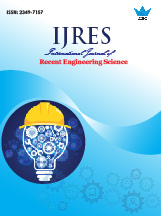Neural Network Based Performance Evaluation of a Waterflooded Oil Reservoir
 |
International Journal of Recent Engineering Science (IJRES) |  |
| © 2021 by IJRES Journal | ||
| Volume-8 Issue-3 |
||
| Year of Publication : 2021 | ||
| Authors : Mahlon Marvin Kida, Zakiyyu Muhammad Sarkinbaka, Abdulhalim Musa Abubakar, Aminullah Zakariyyah Abdul |
||
| DOI : 10.14445/23497157/IJRES-V8I3P101 |
How to Cite?
Mahlon Marvin Kida, Zakiyyu Muhammad Sarkinbaka, Abdulhalim Musa Abubakar, Aminullah Zakariyyah Abdul, "Neural Network Based Performance Evaluation of a Waterflooded Oil Reservoir," International Journal of Recent Engineering Science, vol. 8, no. 3, pp. 1-6, 2023. Crossref, https://doi.org/10.14445/23497157/IJRES-V8I3P101
Abstract
In this paper, we considered the use of neural networks in the identification and prediction of a waterflooded reservoir consisting of eight injection wells and one production well with a 40% porosity. The data used for the non-linear identification was generated from a reservoir modelled in MATLAB Reservoir Simulation Toolbox (MRST). Likewise, in this study, the effect of the number of hidden neurons on the accuracy, Mean Squared Error and oil production prediction of the reservoir were investigated. The study asserted the efficacy of the neural networks as regards their predictive capacity. For the oil production rate, a mean squared error was recorded to be minimal for 2 hidden neurons as compared to the other three cases of neuron number. For water production rate, 8 hidden neurons were observed to be optimal compared to other cases. Oil and water production rate for a peak NPV value of 3 billion US dollars was recorded to be 2000m3/day and 4500m3/day, respectively. The response was optimal for all cases except for the net present value, which requires a more substantial amount of data for the neural network model.
Keywords
MRST, Artificial Neural Networks, Net Present Value, Oil Reservoir, Oil production, Water production.
Reference
[1] Jude Emeka Nwaozo, “Dynamic Optimization of a Water Flood Reservoir,” MSc Thesis, Mewbourne School of Petroleum and Geoligical Engineering, University of Oklahoma, 2006.
[Google Scholar]
[2] Ahmed I. Omar, Zhangxing Chen, and Abdulhadi E. Khalifa, “Predicating Water-flooding Performance into Stratified Reservoirs using a Data Driven Proxy Model,” Journal of Petroleum and Gas Engineering, vol. 8, no. 7, pp. 60-78, 2017.
[CrossRef] [Google Scholar] [Publisher Link]
[3] Xinwei Xiong, and Kyung Jae Lee, “Data Driven Model to Optimize the Injection Well Placement for Waterflooding in Heterogeneous Reserviors Applying Artificial Neural Networks and Reducing Observation Cost,” Energy Exploration & Exploitation, vol. 38, no. 6, pp. 2413–2435, 2020.
[CrossRef] [Google Scholar] [Publisher Link]
[4] Mohammad Ali Ahmadi et al., “Determination of Oil Well Production Performance Using Artificial Neural Network (ANN) Linked to the Particle Swarm Optimization (PSO) Tool,” Petroleum, vol. 1, no. 2, pp. 118–132, 2015.
[CrossRef] [Google Scholar] [Publisher Link]
[5] M. Hamada Ghareb, Elsakka Ahmed, and Y. Nyein Chaw, “Artificial Neural Network (ANN) Prediction of Porosity and Water Saturation of Shaly Sandstone Reserviors,” Advances in Applied Science Research, vol. 9, no. 2, pp. 26–31, 2018.
[Google Scholar] [Publisher Link]
[6] Turgay Ertekin, and Qian Sun, “Artificial Intelligence Applications in Reservoir Engineering: A Status Check,” Energies, vol. 12, no. 15, p. 2897, 2019.
[CrossRef] [Google Scholar] [Publisher Link]
[7] Udy Jackson et al., “Review of Field Development Optimization of Waterflooding, EOR, and Well Placement Focusing on History Matching and Optimization Algorithm,” Process, vol. 5, no. 34, 2017.
[CrossRef] [Google Scholar] [Publisher Link]
[8] Rene Y. Choi et al., “Introduction to Machine Learning, Neural Networks and Deep Learning,” Translational Vision Science & Technology, vol. 9, no. 14, 2020.
[CrossRef] [Google Scholar] [Publisher Link]
[9] Berihun Mamo Negash, and Atta Dennis Yaw, “Artificial Neural Network Based Production Forecasting for a Hydrocarbon Reservior Under Water Injection,” Petroleum Exploration and Development, vol. 47, no. 2, pp. 383–392, 2020.
[CrossRef] [Google Scholar] [Publisher Link]
[10] David M. Himmelblau, “Application of Artificial Neural Networks in Chemical Engineering,” Korean Journal of Chemical Engineering, vol. 17, no. 4, pp. 373–392, 2000.
[CrossRef] [Google Scholar] [Publisher Link]
[11] Zhihao Zhang et al., “Real Time Optimization and Control of Non-linear Processe Using Machine Learning,” Mathematics, vol. 7, no. 10, pp. 890–915, 2019.
[CrossRef] [Publisher Link]
[12] G. Rzevski, “Artificial Intelligence in Engineering: Past, Present and Future,” WIT Transactions on Information and Communication Technologies, vol. 10, 1995.
[CrossRef] [Google Scholar] [Publisher Link]
[13] Ehsan Amirian, and Zhangxing John Chen, “Cognitive Data Driven Proxy Modelling for Performance Forecasting of Waterflooding Process,” Global Journal of Technology & Optimization, vol. 8, no. 1, pp. 1-8, 2017.
[CrossRef] [Google Scholar] [Publisher Link]
[14] Robert J. May et al., “Non-linear Variable Selection for Artificial Neural Networks Using Partial Mutual Information,” Environmental Modelling & Software, vol. 23, no. 10-11, pp. 1312–1326, 2008.
[CrossRef] [Google Scholar] [Publisher Link]
[15] A. S. Grema et al., “Optimization and Non-linear Identification of Reservior Water Flooding Process,” Arid Zone Journal of Engineering, Technology and Environment, vol. 13, no. 5, pp. 610–619, 2017.
[Google Scholar] [Publisher Link]
[16] E. Saber Khaled, “Application of Function Approximations to Reservoir Engineering,” Degree of Doctor of Philosohpy in Process Systems Engineering, University of Regina, 2012.
[Google Scholar] [Publisher Link]
[17] G. Edison, “Improving the Simulation of a Waterflooding Recovery Process Using Artificial Neural Networks,” MSc Thesis Submitted to the College of Engineering and Mineral Resources, West Virginia University, Morgantown, West Virginia, 2000.
[Google Scholar] [Publisher Link]
[18] Sandhya Samarasinghe, Neural Networks for Time series forecasting, in Neural Networks for Applied Sciences and Engineering : From Fundamentals to Complex Pattern Recognition, Auarbach publications, Taylor and Francis Group, 2006.
[Google Scholar]
[19] Daniel Graupe, Principle of Artificial Neural Networks, 3rd edition, Singapore: World Scientific Publishing Co. Pte. Ltd, 2013.
[Google Scholar]
